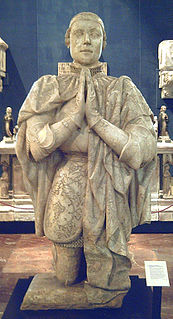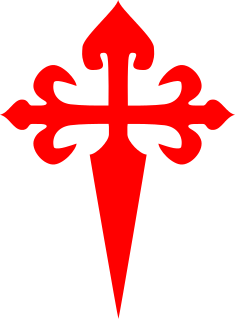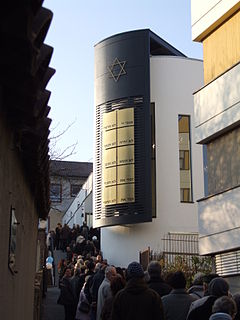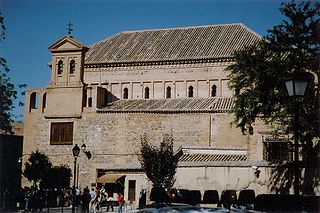
Samuel ben Meir Ha-Levi Abulafia (Úbeda, approx. 1320 - Seville, 1360), was the treasurer of king Pedro I "the Cruel" of Castile and founder of the Synagogue of El Transito in Toledo, Spain.

Úbeda is a town in the province of Jaén in Spain's autonomous community of Andalusia, with 34,733 inhabitants. Both this city and the neighbouring city of Baeza benefited from extensive patronage in the early 16th century resulting in the construction of a series of Renaissance style palaces and churches, which have been preserved ever since. In 2003, UNESCO declared the historic cores and monuments of these two towns a World Heritage Site.

Seville is the capital and largest city of the autonomous community of Andalusia and the province of Seville, Spain. It is situated on the plain of the river Guadalquivir. The inhabitants of the city are known as sevillanos or hispalenses, after the Roman name of the city, Hispalis. Seville has a municipal population of about 690,000 as of 2016, and a metropolitan population of about 1.5 million, making it the fourth-largest city in Spain and the 30th most populous municipality in the European Union. Its Old Town, with an area of 4 square kilometres (2 sq mi), contains three UNESCO World Heritage Sites: the Alcázar palace complex, the Cathedral and the General Archive of the Indies. The Seville harbour, located about 80 kilometres from the Atlantic Ocean, is the only river port in Spain. Seville is also the hottest major metropolitan area in the geographical Southwestern Europe, with summer average high temperatures of above 35 °C (95 °F).

Peter, called the Cruel or the Just, was the king of Castile and León from 1350 to 1369. Peter was the last ruler of the main branch of the House of Ivrea.
Born to the Abu-l-Afiyat family of Tunisian Jewish origins his parents died of plague shortly after arriving in Toledo. First he worked as administrator to the Portuguese knight Juan Alfonso de Alburquerque and became recognized enough to achieve employment at the court of Pedro I of Castile, first as camarero mayor (chamberlain) and later as almojarife (treasurer) and as oídor (judge). His employment ended when the enemies of Pedro I led by Henry of Trastámara organized a pogrom against the Toledan Jewry, which enabled them to assume possession of the royal treasures. The king marched to Toro to demand the return of his belongings, and Samuel Ha-Levi accompanied him, and later supported the King in reclaiming Toledo for the crown, and in the establishment of a peace treaty with the Portuguese at Évora in 1358. [1]

Évora is a city and a municipality in Portugal. The population in 2011 was 56,596, in an area of 1307.08 km². It is the seat of the Évora District. The present Mayor is Carlos Pinto de Sá of the CDU coalition. The municipal holiday is 29 June.
In Toledo he lived in the palace that is today the Museo de El Greco, and with the considerable riches bestowed upon him by his employer he founded the Synagogue of El Transito between 1355 and 1357. [2] The building was one of ten small synagogues serving Toledo's large Jewish population, and while architecturally exquisite its dimensions are not particularly impressive. Its construction was opposed vociferously by the Catholic church, but King Pedro permitted it. [1] Constantly criticized by his rivals for his permissive stance towards Jews, eventually the King turned against ha-Levi and had him incarcerated and tortured on suspicion of embezzlement in 1360. [3] [4] He died under duress of torture. [1]
The prominence of Samuel Ha-Levi at Pedro's court has often been cited as evidence of his supposed pro-Jewish sentiment, but Ha-Levi's success did not necessarily reflect the general experience of the Spanish Jewry in this period which was often marked by discrimination and pogroms. And even Samuel's career shows that the opportunities for Jews were restricted to certain offices and positions whereas other forms of advancement were denied to them. [1]
Spanish Jews once constituted one of the largest and most prosperous Jewish communities in the world. Spain was the unquestioned leader of world Jewry: scientific and philological study of the Hebrew Bible began, secular poetry was written in Hebrew for the first time, and for the only time between Biblical times and the origins of the modern state of Israel, a Jew commanded a Jewish army. This period ended definitively with the anti-Jewish riots of 1391 and the Alhambra Decree of 1492, as a result of which the majority of Jews in Spain converted to Catholicism and those who continued to practice Judaism were forced into exile, although many thousands returned in the years following the expulsion.










